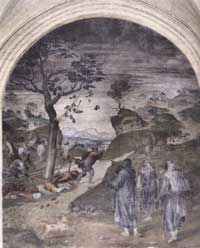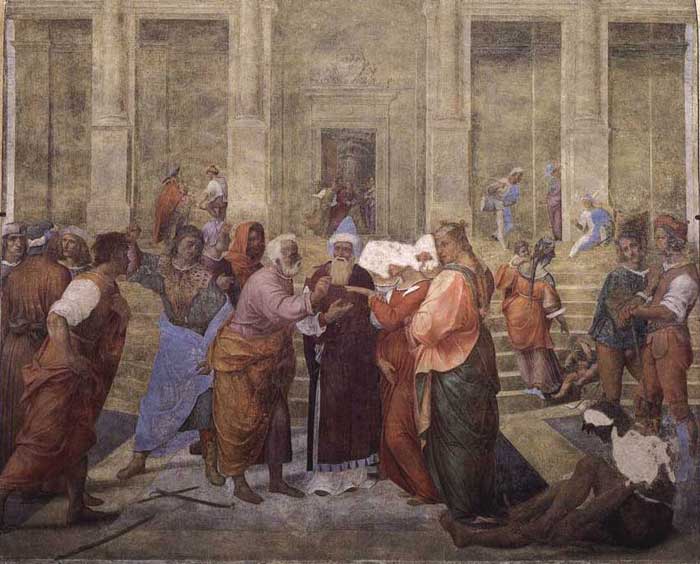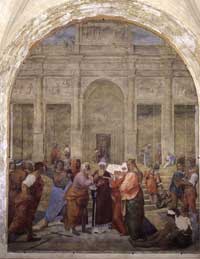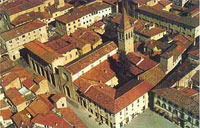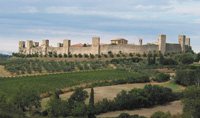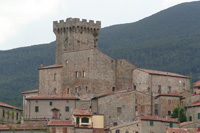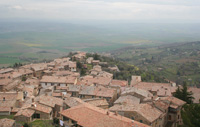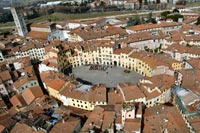| |
|
| |
|
|
|
|
|
|
| |
 |
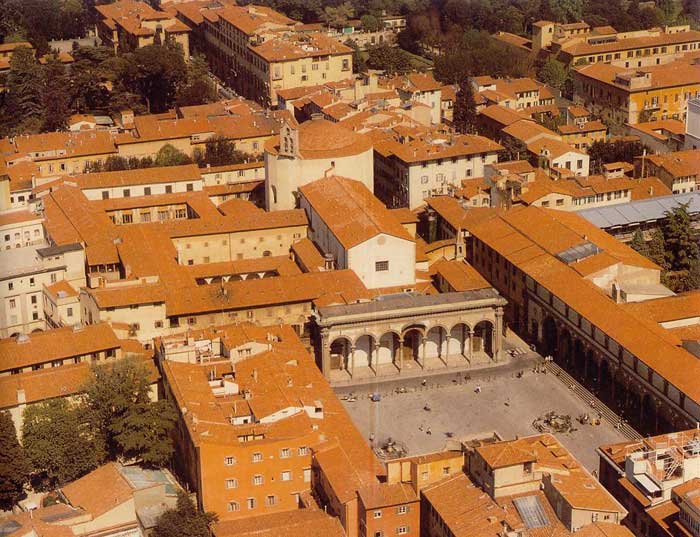 |
Basilica della Santissima Annunziata in Florence
|
|
 |
 |
| |
|
|
|
| |
|
The Basilica della Santissima Annunziata
|
|
|
|
| |
|
One of the most beautiful piazzas in Florence, Piazza della Santissima Annunziata exemplifies the stylistic harmony of some of the greatest architects of the Renaissance. The church that gives the piazza its name, the Santissima Annunziata, lies behind the central portico of the piazza.
|
The Basilica della Santissima Annunziata (Basilica of the Most Holy Annunciation) is a Roman Catholic minor basilica in Florence and the mother church of the Servite order. It is located at the northeastern side of the Piazza Santissima Annunziata.
History
The church was founded in 1250 by the seven original members of the Servite order. In 1252, a painting of the Annunciation, which had been begun by one of the monks but abandoned in despair because he did not feel he could create a beautiful enough image, was supposedly completed by an angel while he slept. This painting was placed in the church and became so venerated that in 1444 the Gonzaga family from Mantua financed a special tribune. Michelozzo, who was the brother of the Servite prior, was commissioned to build it, but since Ludovico II of Gonzaga had a special admiration for Leon Battista Alberti, Alberti in 1469 was given the commission. His vision was limited, however, by the pre-existing foundations. Construction was completed in 1481, after Alberti’s death. Though the space was given a Baroque dressing in the seventeenth century, the basic scheme of a domed circular space flanked by altar niches is still visible.[1]
The facade of the church was added in 1601 by the architect Giovanni Battista Caccini, in imitation of Brunelleschi's facade of the Foundling Hospital, which defines the eastern side of the piazza. The building across from the Foundling Hospital, designed by Antonio da Sangallo the Elder, was also given a Brunelleschian facade in the 1520s.
Veneration
Pilgrims who came to the church to venerate the miraculous painting often left wax votive offerings, many of them life-size models of the donor (sometimes complete with horses). In 1516, a special atrium was built to house these figures, the Chiostrino dei Voti. By the late 18th century there were some six hundred of these images and they had become one of the city's great tourist attractions. In 1786, however, they were all melted down to make candles.
The Florentine brides traditionally visit the shrine to leave their bouquets.
Interior
This church is entered from the Chiostrino dei Voti.[2] The Baroque decoration of the church interior was begun in 1644, when Pietro Giambelli frescoed the ceiling with an Assumption as a centerpiece based on designs by Baldassare Franceschini.
The 1st chapel to right contains a Madonna in Glory by Jacopo da Empoli, with walls frescoed by Matteo Rosselli. The 5th chapel on the right contains a monument to Orlando de' Medici (1456) by Bernardo Rossellino. The right transept has a small side chapel has a Pietà (1559) by Baccio Bandinelli and graces his tomb.
The chapel-surrounded tribune or choir, known as the Rotonda, was designed in turn by Michelozzo and Alberti between 1444–76. Notable among the chapels is the fifth (aligned to nave axis), which has a crucifix (1594–8) by Giambologna for his tomb, with statues of the Active and Contemplative Lives by his pupil Francavilla, saints and angels by Pietro Tacca,[3] and murals by Bernardino Poccetti. The next chapel has a Resurrection (1548–52) by Bronzino with a statue of St. Roch attributed to Veit Stoss. The next chapel has a Madonna with Saints by a follower of Perugino.
|
In the sixth chapel to the left of the nave is a SS Ignatius, Erasmus and Blaise by Raffaellino del Garbo; the next chapel has one of the panels of Annunziata Altarpiece (1507) by Perugino, once at the high altar of the church (the Deposition, begun by Filippino Lippi, is now at the Gallerie dell'Accademia, while other panels are divided between other collections in the world). The altarpiece of the next chapel has a Trinity with Saint Jerome and two saints (c. 1455) by Andrea del Castagno, who also painted the mural of The Vision of St. Julian in the next chapel, called the Feroni chapel. This chapel was elaborately decorated in a baroque fashion by Gianbattista Foggini in 1692. The first chapel just to the left of the entrance has a tabernacle of the Annunciation (1448–52) by Michelozzo and the sculptor Pagno di Lapo Portigiani.
Probably in 1453, Andrea moved to the church of Santissima Annunziata, where he painted two frescoes (St Julian and the Redeemer; The Holy Trinity, St Jerome and Two Saints) that are typical of his late style. No longer interested in the heroic and monumental characteristics illustrated in the Legnaia cycle, Andrea here imbues his figures with the crude truth that he had gradually mastered over a lifetime of hard work.
A deeply realistic mood dominates the figure of St Jerome in the fresco in the Corboli Chapel in the Santissima Annunziata. The saint is portrayed as a fully convinced Renaissance ascetic, possessing both humanity and mysticism. In this painting we are immediately struck by a few details that are so realistic they are almost too crude, like the old saint's body with blood gushing out of the many wounds. Above, the Holy Trinity "with a Crucifix in foreshortening; it is so well executed that Andrea deserves great praise for it, for he painted foreshortenings in a much better and more modern manner than any artist had done before him" (Vasari).
The St Julian in the Cagliani family chapel in Santissima Annunziata is damaged in its lower section. The figure of the saint is no longer the sophisticated gentleman we saw in the Berlin Madonna: he is simply a young man who is sincerely contrite for the harm he has caused. Above his hair, rendered with golden highlights, the metallic halo realistically reflects the saint's head. Above Julian, partly concealed by pinkish clouds, Christ imparts his blessing. On either side of the saint, in the midst of a lovely Tuscan landscape, Andrea has illustrated some episodes from his life.
The organ (1628) is the oldest in Florence and the second oldest in Italy. The church contains the tomb of the Italian writer Maria Valtorta. |
|
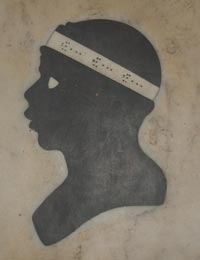 The Pucci crest on the floor of Santissima Annunziata - the headband originally bore three hammers (symbol of the family's ancestral profession), later replaced by three Ts to represent the acronym of the family motto Tempore tempora tempera (time is a great healer [8]) The Pucci crest on the floor of Santissima Annunziata - the headband originally bore three hammers (symbol of the family's ancestral profession), later replaced by three Ts to represent the acronym of the family motto Tempore tempora tempera (time is a great healer [8])
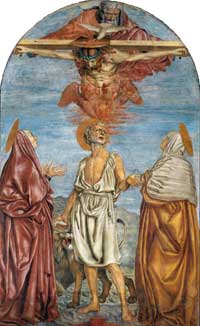 Andrea del Castagno, The Holy Trinity, St Jerome and Two Saints, c. 1453, (fresco), SS. Annunziata, Florence Andrea del Castagno, The Holy Trinity, St Jerome and Two Saints, c. 1453, (fresco), SS. Annunziata, Florence
|
| |
|
|
Cloisters
The Chiostrino dei Voti [4] was designed by Michelozzo. Baldovinetti painted the first lunette in the chiostro in c. 1460. In about 1476 Rosselli began a cycle dedicated to Filippo Benizzi, fifth Prior General of the Servites, which was then completed by Andrea del Sarto 1509–10. (Benizzi was the first Servite to be canonized, though this did not occur until 1671).
|
| Site |
Work |
Date |
Painter |
| |
|
|
|
| 1st R |
Assumption |
1517 |
Rosso Fiorentino |
| 2nd R |
Visitation |
1516 |
Pontormo |
| 3rd R |
Marriage of the Virgin |
1513 |
Franciabigio |
| 4th R |
Birth of the Virgin |
1513-14 |
Andrea del Sarto |
| 5th R |
Voyage of the Magi |
1511 |
Andrea del Sarto |
| 1st-5th L |
Life of S. Filippo Benizzi |
1509-10 |
Andrea del Sarto |
| 6th L |
Life of S. Filippo Benizz |
1476 |
Cosimo Rosselli |
| Just left of entrance to church |
Nativity |
1460-62 |
Alesso Baldovinetti |
|
|
|
|
| |
|
|
|
|
Andrea del Sarto | Scenes from the story of Filippo Benizzi | Punishment of the Gamblers
|
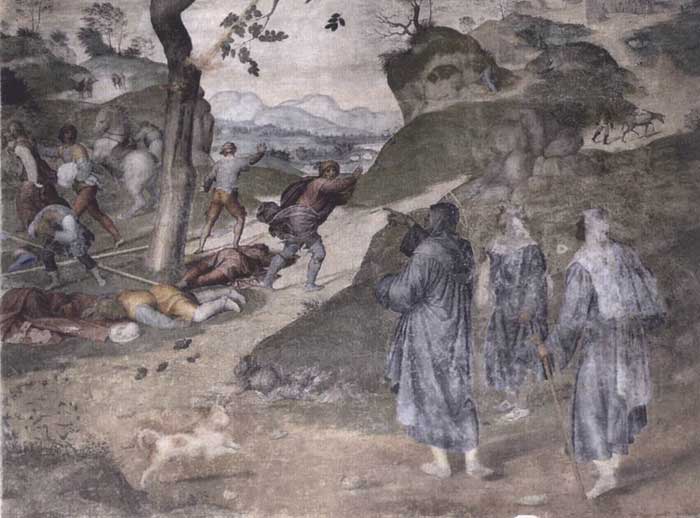 |
Andrea del Sarto, Punishment of the Gamblers, fresco, 360 x 300 cm, Santissima Annunziata (Florence)
|
Andrea del Sarto's impressively fluent and richly lyrical style is manifested first in his series of five mural paintings depicting scenes from the story of the spiritual founder of the Servite Order, Filippo Benizzi. They were created for the atrium of the important pilgrimage church of Santissima Annunziata in Florence from 1509 onwards. They were followed by two more frescoes with biblical subjects on the opposite side of the space, the last of which, the Birth of the Virgin is dated 1514.
Andrea del Sarto's early work echoes of Leonardo, Raphael, and Fra Bartolomeo can be observed, but it is the naturalism of Andrea"'s teacher Piero di Cosimo - in whose shop he remained from about 1498 to 1508 - that is most evident in his frescoes of the life of St Philip Benizzi. There are located in the atrium of the Santissima Annunziata, near Baldovinetti's light-filled Nativity. Throughout the series, Andrea retained the sense of outdoor light and atmosphere seen in Baldovinetti's fresco; this was suggested by the site itself, which was filled with sunlight. The fantastic landscape masses, jutting rocks, and trees in the scene in which the saint punishes gamblers derive from Piero di Cosimo.
Art in Tuscany | Andrea del Sarto |
|
|
| |
|
|
Franciabigio | Marriage of the Virgin
|
|
Franciabigio, Betrothal of the Virgin, 1513, fresco, 395 x 321 cm, Santissima Annunziata, Florence
|
|
The son of a Milanese linen-weaver, Franciabigio was born in Florence, and initially worked under Albertinelli until about 1506. In 1505 he befriended Andrea del Sarto; and by the next year, the two painters set up common shop in the Piazza del Grano. He was proficient in fresco and Vasari claimed that he surpassed all his contemporaries in this method.
The Betrothal of the Virgin in the atrium was considered by Vasari Franciabigio's masterpiece. It contains moderately sized figures and expansive architecture which resembles a church facade with a loggia, perhaps meant as an idealized representation of the Annunziata itself. The painting contains a great deal of anecdotical details and superb portraits of contemporary males at the left edge; furthermore, it features Old Testament scenes in fictive reliefs in the upper architecture.
The fresco is badly damaged by abrasion in the paint layers, in the face of the Virgin and
other places.
Franciabigio's early style is flled with movement and attention to descriptive detail strongly reminiscent of 15th-century Italian painting. In the atrium of the Annunziata in Florence he painted the Marriage of the Virgin (1513) as a portion of a series in which Andrea was chiefy concerned. When the friars uncovered this work before it was quite fnished, Franciabigio was so incensed that, seizing a mason's hammer, he struck at the head of the Virgin and some other heads, and the fresco, which would otherwise be his masterpiece in that medium, was mutilated.[7]
Art in Tuscany | Franciabigio |
|
|
|
|
|
Jacopo Pontormo | Visitation
|
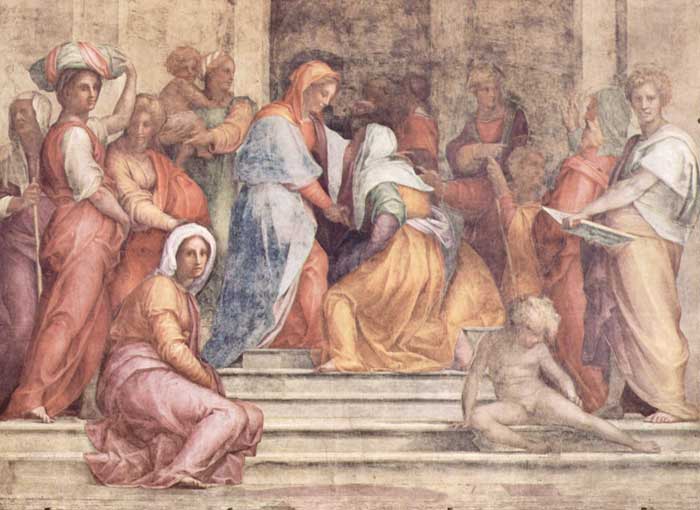 |
Jacopo Pontormo, Visitation, 1514-16, fresco, 392 x 337 cm, Santissima Annunziata, Florence
|
Pontormo painted in and around Florence, often supported by Medici patronage. A foray to Rome, largely to see Michelangelo's work, influenced his later style. Haunted faces and elongated bodies are characteristic of his work. An example of Pontormo's early style is The Visitation of the Virgin and St Elizabeth, with its dancelike, balanced figures, painted from 1514 to 1516.
Like Andrea del Sarto and Rosso, early in his career Pontormo worked in the church of Santissima Annunziata in Florence where he executed the Visitation as part of the decorative cycle of the Scenes from the Life of the Virgin in the Chiostrino dei Voti.
The painting depicts the meeting of Mary and her cousin Elizabeth, both with child, symbolically prefiguring the future interaction of their sons, Jesus and John the Baptist. Pontormo shows himself as under the spell of Raphael, arranging his composition on a set of low steps, similar to Raphael's School of Athens. There is an element of refinement and elegance in this work of Pontormo, both in the poses of the figures and in the creation of the architectural backdrop.
This early Visitation makes an interesting comparison with his painting of the same subject (at right), which was done about a decade later for the parish church of St. Michael in Carmignano, about 20 km west of Florence. Placing these two pictures together—one from his early style, and another from his mature period—throws Pontormo's artistic development into sharp relief. In the earlier work, Pontormo is much closer in style to his teacher, Andrea del Sarto, and to the early sixteenth century renaissance artistic principles.
Art in Tuscany | Jacopo Pontormo |
|
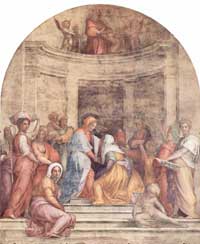
Jacopo Pontormo, Visitation, 1514-16, Santissima Annunziata, Florence
|
| |
|
|
Alessio Baldovinetti, Nativity
|
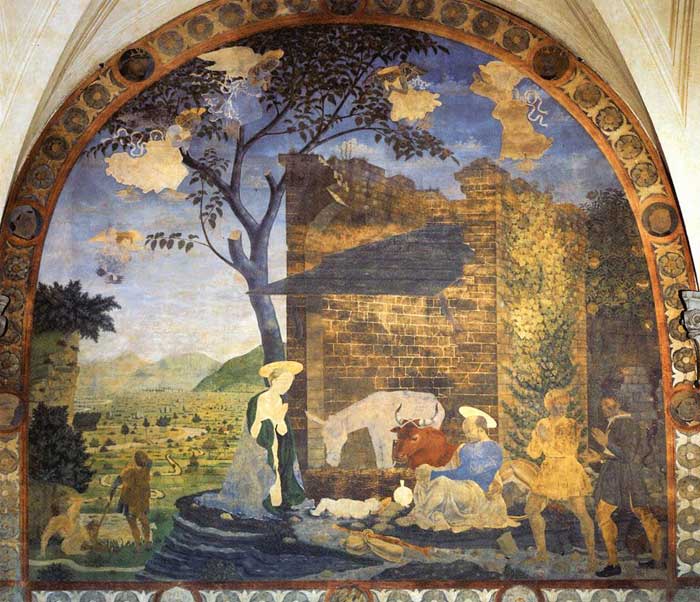 |
Alessio Baldovinetti, Nativity, fresco, 400 x 430 cm, Santissima Annunziata, Florence
|
Baldovinetti's Annunciation is in the atrium of Santissima Annunziata in Florence.[6] His interest in local landscape is evident in the Arno Valley view that he chose as the background of this fresco. In fact he painted only a few portions of the picture in true fresco, and then waited until the plaster had dried so that he could paint 'a secco.' But because the fresco was located in an atrium exposed to winter fogs and even rain, in time the a secco faces, hands, and drapery peeled off, and his underdrawing is now visible. Even so, the painting is impressive in the airy openness of its setting and the view over the expansive Tuscan plain, which is filled with the light of a clear winter day.
|
Another cloister, known as the Chiostri dei Morti, contains the famous Madonna del Sacco (1525) by del Sarto. The Cappella di San Luca, which opens off it, has belonged to the artists confraternity or the Accademia delle Arti del Disegno since 1565. Many artists are buried in its vault, including Benvenuto Cellini, Pontormo, Franciabigio, Giovanni Angelo Montorsoli and Lorenzo Bartolini. Inside is Pontormo’s Holy Family (c. 1514) painted for church of St. Ruffillo and murals by Alessandro Allori: Trinity; Vasari: St. Luke paints Madonna; and Santi di Tito: Solomon directs the construction of the temple of Jerusalem. The ten large stucco figures were sculpted by Vincenzo Danti, Montorsoli and others.[5]
|
 |
Giorgio Vasari, St Luke Painting the Virgin, after 1565, fresco, Santissima Annunziata, Florence
|
Piazza della Santissima Annunziata
|
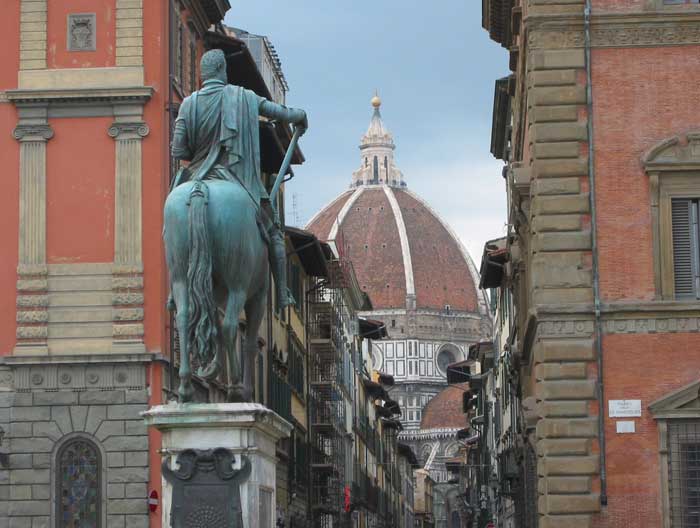 |
Piazza della Santissima Annunziata and Giambologna's last statue, of Ferdinando I de' Medici
|
Piazza della Santissima Annunziata is ocated near piazza San Marco and piazza del Duomo is an harmonious square which overlook the Ospedale degli Innocenti, the Loggia dei Servi di Maria, the Budini Gattai palace and the National Archaeological Museum.
The beautiful Piazza Annunziata is bordered on three sides by a portico or loggia. The portico on the east side is the oldest and belongs to Il Ospedale degli Innocenti or The Hospital of the Innocents. It is no ordinary portico, but one with a special position in the history of architecture. This was the first major work to be designed, in the new Renaissance style, by one of the greatest architects of the age, Filippo Brunelleschi.
The area of the piazza was chosen in 1250 as a space for a little church. At the time the piazza lay in open countryside outside the walls of Florence, in an area called Cafaggio. The church houses the Miraculous Annunciation, a masterpiece that according to legend was painted by an angel. The church became the destination of pilgrimages and processions and it soon became necessary to expand the church and the piazza, in addition to connecting it to the city center.
The piazza is flanked by the Brunelleschi-designed and La Robbia-decorated façade of the Spedale degli Innocenti which was the first orphanage in Europe. The building is inspired by classical models that Brunelleschi studied in Rome. The facade of this complex to house orphans uses slender Corinthian columns to support round arches and a simple horizontal entablature. The cornice serves as a base for a row of windows with classically-inspired pediments, one centered above each arch. The distance between the columns is the same as the distance from the columns to the wall. The distance between the floor of the loggia to just above the impost blocks is also the same. Thus the cube is a major module in this proportional design. Other geometrical relationships governed the location of the cornice, the widths of doors and the heights of windows.
Under the loggia of the hospital, is still possible to observe the famous wheel where you could anonymously leave babies by placing them into a cavity that opened as the wheel turned. Ophans were called Innocents, which is still how they are commonly called in Florence. The Spedale today houses a museum as well as some offices of UNICEF.
A century later, Antonio Sangallo the Elder copied the design in his Loggia dei Serviti (1516-25), which lies on the opposite side of the square. The only real difference between the two designs is that in the latter the spandrels between the arches are decorated with the symbol of the Servite order rather than with images of foundlings.
Giambologna's last statue, of Ferdinando I de' Medici, was finished by his student Pietro Tacca and sits in the center of the piazza. Tacca also designed the two Baroque bronze fountains on the piazza.
On the south side of the piazza lies the Palazzo Gattai Puddings, formerly Palazzo Grifoni, built in 1563-1574 by Bartolomeo Ammannati for the Secretary of Cosimo di Jacopo Ugolino Grifoni. The Palazzo Grifoni is an outstanding example of Florentine palace architecture of the Renaissance. Ugolino Grifoni, secretary of the Grand-Duke of Tuscany Cosimo I, commissioned the architect Bartolomeo Ammannati to build it between 1561 and 1564. The Budini Gattai family, which acquired the building in 1890, then proceeded to a total renovation of its interior. The lavishly decorated and frescoed rooms on the piano nobile are among the most important, and at the same time best preserved, examples of upper-middleclass interior decoration in Florence at the turn of the century. It was to these magnificent rooms in the Palazzo Grifoni that the Photo Library of the Kunsthistorisches Institut in Florenz – Max-Planck-Institut was transferred in January 2010.
Since November 2006, the ancient entrance to the National Archaeological Museum of Florence has been reopened in the piazza, after being closed due to major damage from the flood of Florence in 1966.
Today the piazza is the spot for special festivals and holidays such as the March 25 Feast of the Annunciation and the September 7 Rificolona day.
Art in Tuscany | Fra Angelico | Paintings for the Armadio degli Argenti (1451-52)
|
|
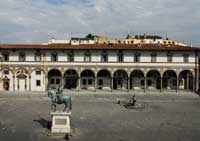
The Hospital of the Innocents, façade by Filippo Brunelleschi
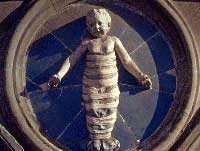
|
|
|
| |
|

Tuscany | Transport in Florence
Most part of the Cloister of SS. Annunziata is today the seat of Istituto Geografico Militare (IGM). In 2007, in the west part of the cloister occupied by the Istituto, the art historian Roberto Manescalchi found a monumental stair by Michelozzo, previously hidden, an Annunciation by Paolo Uccello, some 'Grottesche' frescoes by Morto da Feltre and some frescos of birds flying by Leonardo da Vinci, who lived there.
Roberto Manescalchi, Leonardo all'Annunziata. Pagine Nuove dell'Arte e dell'Architettura N. 3, Grafica European Center of Fine Arts, Firenze 2009. ISBN 978-8-8954-5021-6
Roberto Manescalchi, Le grottesche del Morto nel convento della SS Annunziata a Firenze. Bollettino degli Ingegneri N. 10, Milano 2004.
Roberto Manescalchi, Paolo Uccello: un affresco dimenticato? - Paolo Uccello: A Forgotten Fresco?, Grafica European Center of Fine Arts, Firenze 2006. ISBN 978-8-8954-5019-3
Roberto Manescalchi, La scoperta di un Michelozzo inedito: una scala dimenticata nel convento dell’Annunziata. Ananke N. 43, Firenze 2004

[1] Franco Borsi. Leon Battista Albert. (New York: Harper & Row, 1977)
[2]Eve Borsook, The Companion Guide to Florence, 5th edition, Harper Collins 1991. page 246.
[3]Tacca is also buried in the church.
[4] E. Borsook, page 246.
[5] E Borsook. page 247.
[6] Alessio Baldovinetti was a Florentine painter, mosaicist, and worker in stained glass. His training is unknown, but his graceful, and refined style shows the influence of Domenico Veneziano and Fra Angelico. His finest works include a damaged but still enchanting fresco of the Nativity (1460-62) in the forecourt of the SS. Annunziata, Florence, a Madonna and Child (c. 1460) in the Louvre, Paris, and an Annunciation (c. 1460) in the Uffizi, Florence. They show his remarkable sensitivity to light and landscape and his engaging blend of naivety and sophistication. In his History of Italian Renaissance Art (1970), Frederick Hartt writes that Baldovinetti was 'the finest painter in Florence ' in the 1460s, and considers him 'a very gifted master who somehow never quite seemed to fulfil his great initial promise'.
[7] Franciabigio, also called Francesco di Cristofano, Francesco Giudini, or Francesco Giudici (born 1482/83, Florence [Italy]—died 1525, Florence), Italian Renaissance painter, best known for his portraits and religious paintings. His style included early Renaissance, High Renaissance, and proto-Mannerist elements.
Franciabigio had completed an apprenticeship under his father, a weaver, by 1504. He probably then trained under the Italian painter Mariotto Albertinelli before forming a joint workshop with a leading Florentine painter, Andrea del Sarto, about 1506. Their relationship became tense after 1509, when Andrea began receiving more commissions and more praise for his work, and Franciabigio began to live in his shadow.
Franciabigio's early style is flled with movement and attention to descriptive detail strongly reminiscent of 15th-century Italian painting. He was attracted to the Florentine works of Raphael, as can be seen in his Madonna del Pozzo (c. 1508).
For a number of years, Franciabigio maintained the studio with Andrea. Together with Andrea's student, Jacopo da Pontormo, they decorated the Medici villa at Poggio a Caiano, where Franciabigio's Triumph of Caesar displays his talent for narrative painting. Andrea's infuence on Franciabigio may be seen in the dark, smoky background and the soft, dramatic lighting of the St. Job Altar (1516). One of his best-known later paintings is his Story of Bathsheba (1523), which brings to mind the poses of some of Michelangelo's fgures on the Sistine Chapel ceiling.
[8] V&A Museum - Hidden Histories
|

Travel guide for tuscany | Art, history, hidden secrets and holiday homes in Tuscany | Podere Santa Pia
|
| |
| |
|
|
|
|
|
|
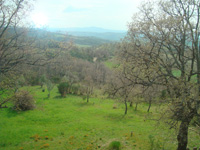
. |
|
|
Podere Santa Pia |
|
Podere Santa Pia, garden view, April |
|
Sansepolcro |
| |
|
|
|
|
|
|
|
|
|
Monteriggioni |
|
Arcidosso
|
|
Montalcino |
| |
|
|
|
|
Florence and Surroundings Tuscany
|
Fiesole, Settignano and Certosa are just a few places just outside of Florence that merit a visit.
In Fiesole's park one can enjoy a captivating view over the city of Florence. Also in the park one will find a statue dedicated to the three Carabinieri (government policeman) who gave their lives in exchange to save a group of hostages taken by the Nazis in 1944. Further down hill find the equestrian statue of Oreste Calzolari.Leaving Fiesole, and heading back down the hill to Florence, you can admire other lovely landscapes like the hamlet of San Domenico or the old road of Fiesole, the Vecchia Via Fiesolana, where you can see a tabernacle with the Virgin Mary and Saints. The Villa Medici, built by Michelozzo is also found along this road. The house was built in 1458 for Cosimo the elder but was mainly used by Lorenzo the Magnificent for social gatherings. If you turn right at San Domenico you will come upon Fiesole's original antique cathedral, Badia Fiesolana. The church was restored extensively in the 15th century but the 12th century façade still remains.
Settignano | Settignano is a picturesque frazione ranged on a hillside northeast of Florence, Italy, with spectacular views that have attracted American expatriates for generations. The little borgo of Settignano carries a familiar name for having produced three sculptors of the Florentine Renaissance, Desiderio da Settignano and the Gamberini brothers, better known as Bernardo Rossellino and Antonio Rossellino. The young Michelangelo lived with a sculptor and his wife in Settignano—in a farmhouse that is now the "Villa Michelangelo"— where his father owned a marble quarry. In 1511 another sculptor was born there, Bartolomeo Ammanati. The marble quarries of Settignano produced this series of sculptors.
Roman remains are to be found in the borgo which claims connections to Septimus Severus—in whose honor a statue was erected in the oldest square in the 16th century, destroyed in 1944— though habitation here long preceded the Roman emperor. Settignano was a secure resort for estivation for members of the Guelf faction of Florence. Giovanni Boccaccio and Niccolò Tommaseo both appreciated its freshness, among the vineyards and olive groves that are the preferred setting for even the most formal Italian gardens.
Mark Twain and his wife stayed at the Villa Viviani in Settignano from September 1892 to June 1893, and greatly enjoyed their visit. Twain was very productive there, writing 1,800 pages including a first draft of Pudd'nhead Wilson. He said the villa "afford[ed] the most charming view to be found on this planet."
In 1898, Gabriele d'Annunzio purchased the trecento Villa della Capponcina on the outskirts of Settignano, in order to be nearer to his lover Eleanora Duse, at the Villa Porziuncola. Near Settignano are the Villa Gamberaia, a 14th-century villa famous for its 18th-century terraced garden, and secluded Villa I Tatti, the villa of Bernard Berenson, now a center of art history studies run by Harvard University.
Gardens in Tuscany | Villa i Tatti in Settignano
Certosa di Firenze or Certosa del Galluzzo is a charterhouse, or Carthusian monastery, located in the Florence suburb of Galluzzo. The building is a walled complex located on Monte Acuto, at the point of confluence of the Ema and Greve rivers.
The charterhouse was founded in 1341 by the Florentine noble Niccolò Acciaioli, Grand Seneschal of the Kingdom of Naples, but continued to expand over the centuries as the recipient of numerous donations. In 1958 the monastery was taken over by Cistercian monks.
The chapter house now holds lunettes from the cloister, frescoed by Pontormo, damaged by exposure to the elements.
The charterhouse inspired Le Corbusier for his urban projects.
Florence | Transport
|
 |
|
|
Choosing one of the Florence walking tours you'll be able to visit the world-famous museums of the Uffizi and Accademia Galleries, discovering the main historical and artistic treasures of the city.
The tours focus on Florence's major sights and attractions, including the Duomo, the Ponte Vecchio and the city's famous churches and Renaissance palaces.
Novelist Henry James called Florence a “rounded pearl of cities -- cheerful, compact, complete -- full of a delicious mixture of beauty and convenience.” The best way to experience the Italian city’s artistry, history and joy of life is by walking the same paths that the Medicis, Michelangelo and James once used.
1 | A Walk Around the Uffizi Gallery
2 | Quarter Duomo and Signoria Square
3 | Around Piazza della Repubblica
4 | Santa Maria Novella
5 | San Niccolo Neighbourhood in Oltrarno
6 | Walking in the Bargello Neighbourhood
7 | From Fiesole to Settignano
|
|
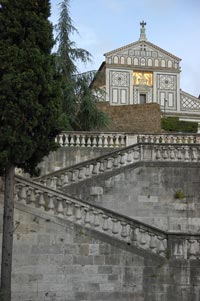
San Miniato al Monte |
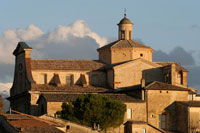
|
|
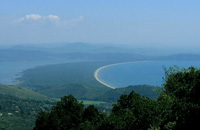 |
|
|
Montefalco |
|
Monte Argentario, Tombolo di Feniglia
|
|
Lucca, Anfiteatro |
This article incorporates material from the Wikipedia article Santissima Annunziata, Florence published under the GNU Free Documentation License, and media related to Santissima Annunziata (Firenze) at Wikimedia Commons. |
|
|
| |
|
|
|
| |
|
|
|
| |
|
|
|
| |
|
|
|
| |
|
|
|
| |
|
|
|
![]()
![]()
![]()
![]()
![]()





